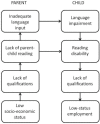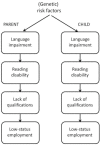Ten questions about terminology for children with unexplained language problems
- PMID: 25142090
- PMCID: PMC4314704
- DOI: 10.1111/1460-6984.12101
Ten questions about terminology for children with unexplained language problems
Abstract
Background: In domains other than language, there is fairly consistent diagnostic terminology to refer to children's developmental difficulties. For instance, the terms 'dyslexia', 'attention deficit hyperactivity disorder' and 'autistic spectrum disorder' are used for difficulties with reading, attention or social cognition, respectively. There is no agreed label, however, for children with unexplained language problems.
Aims: To consider whether we need labels for unexplained language problems in children, and if so, what terminology is appropriate.
Main contribution: There are both advantages and disadvantages to labels, but they are important to ensure children receive services, and to increase our knowledge of the nature and causes of such problems. A survey of labels in current use found 132 different terms, 33 of which had 600 or more returns on Google Scholar between 1994 and 2013. Many of these labels were too general to be useful. Of the remainder, the term 'specific language impairment' was the most commonly used.
Conclusions: The current mayhem in diagnostic labels is unsustainable; it causes confusion and impedes research progress and access to appropriate services. We need to achieve consensus on diagnostic criteria and terminology. The DSM-5 term 'language disorder' is problematic because it identifies too wide a range of conditions on an internet search. One solution is to retain specific language impairment, with the understanding that 'specific' means idiopathic (i.e., of unknown origin) rather than implying there are no other problems beyond language. Other options are the terms 'primary language impairment', 'developmental language disorder' or 'language learning impairment'.
Keywords: DSM-5; diagnosis; labels; specific language impairment; terminology.
© 2014 The Authors International Journal of Language & Communication Disorders published by John Wiley & Sons Ltd on behalf of Royal College of Speech and Language Therapists.
Figures




References
-
- American Psychiatric Association. Diagnostic and Statistical Manual of Mental Disorders, 4th Edition. Washington, DC: American Psychiatric Association; 1994.
-
- American Psychiatric Association. Diagnostic and Statistical Manual of Mental Disorders (5th ed.): DSM-5. Arlington, VA: American Psychiatric Publ; 2013.
-
- American Speech–Language–Hearing Association. Incidence and Prevalence of Communication Disorders and Hearing Loss in Children—2008 Edition. 2008. (available at: http://www.asha.org/research/reports/children.htm )
-
- American Speech–Language–Hearing Association. Language-Based Learning Disabilities. n.d., (available at: http://www.asha.org/public/speech/disorders/lbld.htm )
Publication types
MeSH terms
Grants and funding
LinkOut - more resources
Full Text Sources
Other Literature Sources

